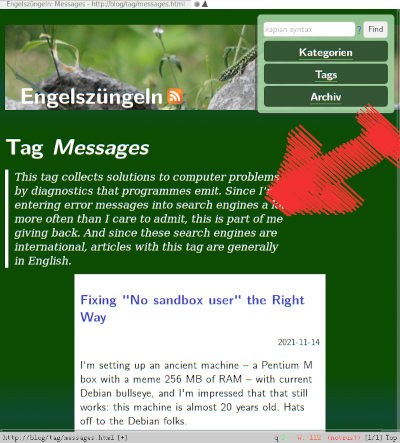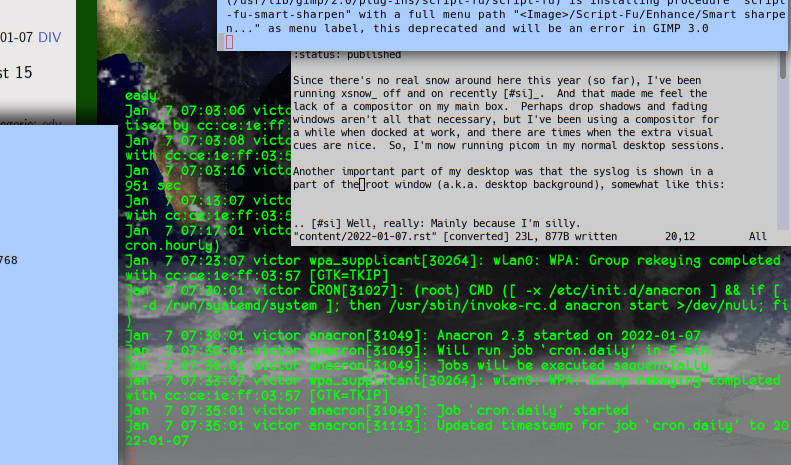Quick RST Previews for Posts in Pelican
In January, I described how I use this blog's engine, pelican, and how I have a “development” and a “production” site (where I will concede any time that it's exceedingly silly to talk about “production” in this context). Part of that was a trivial script, remake.sh, that I would run while writing and revising a post to format it without doing too much unnecessary work. This script was running between a couple and a couple of dozen times until I was happy with an article.
What the script did was call pelican asking to only write the document being processed. When pelican was instructed to cache work on the other articles, that was enough to keep build times around a second on my box; but as the number of posts on this blog approaches 200, build times ended up on the totally wrong side of that second, and I thought: “Well, why don't I run, perhaps, rst2html for formatting while revising?” That would be, essentially, instantaneous.
But pelican does a lot more than rst2html. Especially, having the plugins and the templating available is a good thing when inspecting a post. So, I got to work and figured out how pelican builds a document. The result is a script build-one that only looks at a single (ReStructuredText) article – which it gets from its command line – and ignores everything else.
This is fast enough to be run whenever I save the current file. Therefore, in my pelican directory I now have, together with the script, the following .vimrc enabling just that (% expands to the file currently edited in vim):
augroup local au! autocmd BufWritePost *.rst !python build-one % augroup END
I've briefly considered whether I should also add some trick to automatically reload a browser window when saving but then figured that's probably overdoing things: In all likelihood I want to scroll around in the rendered document, and hence I will have to focus it anyway. If I do that, then effort spent on saving pressing r after focusing feels misplaced.
The script does have an actual drawback, though: Since pelican does not get to scan the file system with build-one, it cannot do file name substitution (as in {filename}2022-05-26.rst) and will instead warn whenever seeing one of these. Since, as described in January, my static files are not managed by pelican, that is not a serious problem in my setup, except I have to watch out for broken substitutions when doing a final make html (or the make install).
Insights into Pelican
It took me a bit to figure out how the various parts of pelican fit together at least to the extent of letting me format a ReStructuredText document with the jinja templates. Let me therefore briefly discuss what the script does.
First, to make pelican do anything remotely resembling what it will do on make html, you have to load its settings; since I assume I am running in pelican's directory and this is building a “draft” version, I can simply do:
settings = pelican.read_settings("pelicanconf.py")
With that, I already now where to write to, which lets me construct a writer object; that will later arrange for actually placing the files. I can also construct a reader for my ReStructuredText files (and you would have to change that if you are writing in Markdown); these readers decouple the Article class from input formats:
writer = writers.Writer(settings["OUTPUT_PATH"], settings) reader = readers.RstReader(settings)
With that, I have to delve deep into pelican's transformation machinery, which consists of various generators – for articles, static files, pages, whatever. The constructors of these generator classes (which are totally unrelated to Python generators) take a lot of arguments, and I cannot say I investigated why they insist on having them passed in when I fill them with data from settings anyway (as does pelican itself); but then I suspect these extra arguments are important for non-Article generators. I only need to generate a single article, and so stereotypically writing:
artgen = generators.ArticlesGenerator(
settings.copy(), settings,
settings["PATH"], settings["THEME"], settings["OUTPUT_PATH"])
does the trick for me.
Article generators will usually collect the articles to generate by looking at the file system. I don't want that; instead, I want to construct an Article instance myself and then restrict the generator's action to that.
The Article class needs to be constructed with content and metadata, which happen to be what readers return. So, to construct an Article from the RST file passed in in source_path, I need to say:
content, metadata = reader.read(source_path)
art = contents.Article(content, metadata,
source_path=source_path, settings=settings)
After all that preparation, all that is left to do is overwrite any misguided ideas the article generator might have on what I would like to have processed and then let it run:
artgen.translations = []
artgen.articles = [art]
artgen.generate_articles(
functools.partial(writer.write_file, relative_urls=True))
(the currying of the writer's write_file method to make sure it creates relative URLs you can probably do without, but I'm a fan of relative URLs and of almost anything in functools).
![[RSS]](../theme/image/rss.png)












